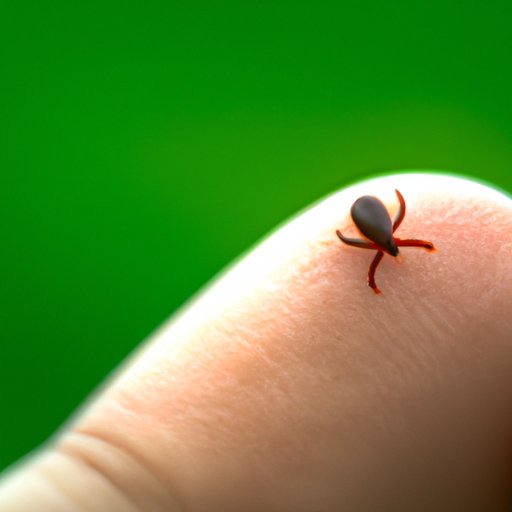
Introduction
Picture this: a warm summer day, the sun is shining, and you’re enjoying your favorite outdoor activity. Suddenly, you feel a small, pesky something crawling on your skin. You look down, and to your horror, you discover a tick. Fear takes hold because you’ve heard about the dangers of Lyme disease, an illness caused by tick bites. But, do all ticks have Lyme disease? In this article, we’ll explore this question in depth, helping you to understand what you need to know to stay safe from tick-borne illnesses.
Debunking the Myth: Not All Ticks Carry Lyme Disease
There is a common misconception among the general public that all ticks carry Lyme disease. However, this is not true. In reality, only certain species of ticks carry the bacterium that causes Lyme disease. The black-legged tick, also known as the deer tick, is the primary carrier of the Lyme disease bacterium in the United States. Other tick species, such as the American dog tick and the Lone star tick, do not commonly carry Lyme disease.
The reason why some ticks do not carry Lyme disease is due to the biology of the bacteria and the tick. The bacterium that causes Lyme disease, Borrelia burgdorferi, is transmitted to ticks from small animals, such as mice and squirrels. Not all ticks encounter these animals during their life cycle, so they are not able to carry Lyme disease.
The Truth About Lyme Disease and Ticks: What You Need to Know
Lyme disease is an infectious illness caused by the bacteria Borrelia burgdorferi, which is spread by the bite of an infected tick. The disease is prevalent in the Northeastern and Midwestern regions of the United States, but it can occur in other regions as well. Symptoms of Lyme disease can include fever, headache, fatigue, and a characteristic bull’s-eye rash. If left untreated, Lyme disease can cause severe joint pain, neurological problems, and heart problems.
Tick-Borne Illnesses: Lyme Disease vs. Other Infections
Lyme disease is not the only illness that can be transmitted through tick bites. There are several other tick-borne illnesses, such as Rocky Mountain Spotted Fever and Babesiosis. The symptoms of these illnesses can be similar to those of Lyme disease, so it is important to seek medical attention if you are experiencing any tick-borne illness symptoms.
The treatment for these illnesses can vary, depending on the specific infection. Antibiotics are usually prescribed for Lyme disease, while Rocky Mountain Spotted Fever may require hospitalization. Prevention is the best defense against tick-borne illnesses, so be sure to take careful precautions when spending time outdoors.
Tick Testing: Understanding the Risk of Lyme Disease Infection
If you have been bitten by a tick, your healthcare provider may recommend testing for Lyme disease. There are several different types of tests available, including blood tests and DNA tests. However, it’s important to note that these tests are not always accurate, especially if they are done too soon after the tick bite.
There are risks and benefits to getting tested for Lyme disease. If you test positive, your healthcare provider can prescribe antibiotics to treat the infection. However, if you test negative, it does not necessarily mean you are in the clear. False negatives are possible, especially in the early stages of infection.
Prevention and Protection: How to Stay Safe from Lyme Disease
Prevention is key when it comes to avoiding tick bites and Lyme disease. You can take steps to protect yourself, such as wearing long pants and sleeves, using insect repellent, and avoiding areas with high grass and brush. If you do find a tick on your skin, it’s important to remove it as soon as possible. Use tweezers to grasp the tick as close to the skin as possible and pull straight up. Do not twist or jerk the tick, as this can cause the mouthparts to remain in the skin.
If you live in an area with a high risk of Lyme disease, you can also take measures to control ticks in your yard. Keep your grass short, remove leaf litter and debris, and create a barrier of wood chips or gravel between your lawn and any adjacent wooded areas.
Ticks and Lyme Disease: The Importance of Early Detection
Early detection is crucial when it comes to treating Lyme disease. The longer the bacteria remain in your body, the more difficult it can be to treat. If you suspect you have been bitten by a tick, keep an eye out for any symptoms of Lyme disease, such as fever, headache, and rash. If you experience any of these symptoms, seek medical attention right away.
The treatment for Lyme disease typically involves a course of antibiotics. In some cases, intravenous antibiotics may be necessary. It is important to finish the entire course of antibiotics, even if you are feeling better, to ensure that the infection is fully treated.

Lyme Disease Misconceptions: Dispelling Common Myths about Ticks
There are several common myths surrounding ticks and Lyme disease. One of the biggest misconceptions is that Lyme disease can only be transmitted by deer ticks. In reality, other tick species can also transmit Lyme disease. Another myth is that if you don’t have a bull’s-eye rash, you don’t have Lyme disease. However, not all individuals with Lyme disease develop a bull’s-eye rash.
It’s important to dispel these myths for public health reasons. By understanding the truth about Lyme disease and ticks, individuals can take proactive steps to protect themselves and their families.
Conclusion
In conclusion, not all ticks carry Lyme disease, but it’s important to take precautions when spending time outdoors. Prevention is key when it comes to avoiding tick bites and Lyme disease. If you do find a tick on your skin, remove it promptly and keep an eye out for any symptoms of tick-borne illnesses. With early detection and treatment, Lyme disease is highly treatable. Remember to stay safe when enjoying the great outdoors and spread awareness to debunk any myths about ticks and Lyme disease.




